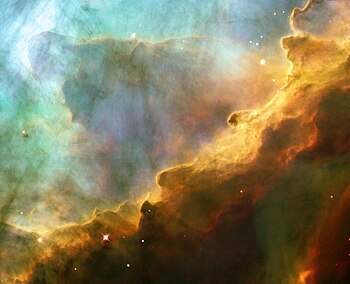Portál:Astronomie/Vybraný obrázek/16

Mlhovina Omega je emisní mlhovina. Jedná se o oblast, ve které vznikají hvězdy. Název pochází od Williama Herschela, kterému její tvar připomínal řecké písmeno omega (Ω). Její jasnost je 7,0 mag; jde tedy o mlhovinu, kterou lze pozorovat i triedrem.
Média použitá na této stránce
The photograph, taken by NASA's Hubble Space Telescope, captures a small region within M17, a hotbed of star formation. M17, also known as the Omega or Swan Nebula, is located about 5500 light-years away in the constellation Sagittarius.
The wave-like patterns of gas have been sculpted and illuminated by a torrent of ultraviolet radiation from young, massive stars, which lie outside the picture to the upper left. The glow of these patterns accentuates the three-dimensional structure of the gases. The ultraviolet radiation is carving and heating the surfaces of cold hydrogen gas clouds. The warmed surfaces glow orange and red in this photograph. The intense heat and pressure cause some material to stream away from those surfaces, creating the glowing veil of even hotter greenish gas that masks background structures. The pressure on the tips of the waves may trigger new star formation within them.
The image, roughly 3 light-years across, was taken May 29-30, 1999, with the Wide Field Planetary Camera 2. The colors in the image represent various gases. Red represents sulfur; green, hydrogen; and blue, oxygen.